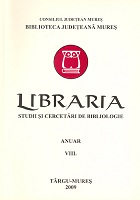Alteritate şi identitate religioasă. Consideraţii cu privire la reprezentarea „ereticului” în literatura tipărită în Moldova la mijlocul secolului al XVII-lea (II)
Religious Identity and Otherness. Considerations Regarding the Representation of the „Heretic” in the Moldavian Printed Works at the Middle of the XVIIth Century
Author(s): Carmen Maria DorlanSubject(s): Christian Theology and Religion, Library and Information Science, 17th Century, Eastern Orthodoxy, Philology, History of Religion, Identity of Collectives
Published by: Biblioteca Județeană Mureș
Keywords: religious identity; the “heretic”; Moldavia; printed works; Orthodoxy; confessions;
Summary/Abstract: Analysing the content of the printed works in Moldavia at the middle of the XVIIth century, the present paper intends to approach the category „heretic” as a main instrument used in order to better understand the transformation known by the Moldavian ecclesiastical élite at the level of religious imagination, cultural and ecclesiastical politics and the process of religious identity construction. Focusing on the polemical context resulted of the synodal activity at Iaşi, in 1642, the printed works edited the following years are used in order to reconstruct a social typology and to reflect on the way this ecclesiastical élite thought and represented the religious otherness, the politics elaborated at this moment, taking into consideration the fact that any attempt to reconstruct the evolution of a mental representation implies social and temporal contextualising and the significance attributed to it is mobile. It also intends to define the opportunities instrumented by this type of religious propaganda to strengthen the Orthodox Eastern identity and the social control at the lower levels of ecclesiastical structures, revealing a religious discourse on the social relations and realities much more polemic, based on exclusion and marginalization. Identified with the confessions resulted after the Reformation, but also with the Armenian communities existing here, the reconstruction of the „heretic” social type reflects an important effort sustained by these categories intended to improve the sense of religious self-consciousness. On the other hand, edited sources used to reflect this discourse, reveal an important change regarding the process of cultural and religious communication, being percieved as such and instrumented as a vehicle in the process of transmitting information. They also represent important sources for the patterns developed by the Romanian communities as far as religous identity is concerned, during the following centuries.
Journal: Libraria. Studii și cercetări de bibliologie
- Issue Year: XVIII/2009
- Issue No: 8
- Page Range: 158-169
- Page Count: 12
- Language: Romanian

